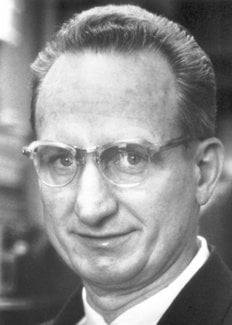James Rainwater
Biographical

I was born December 9, 1917 in a small town in Idaho (Council) where my parents had moved to from California to operate a general store. My father, who had previously been a civil engineer, died in the great influenza epidemic of 1918. My mother then moved with me and her mother to Hanford, Calif. in the San Joaquin Valley of California, where she was re-married to George Fowler a few years later. In my schooling through high school, I excelled mainly in chemistry, physics and mathematics. Due mainly to my record on an open chemistry competition given by Cal Tech, I was admitted, graduating in 1939 as a physics major. Carl David Anderson was my physics group recitation instructor when he received his Nobel Prize and Milliken was the President of the Institute. I had a short biology course taught by Thomas Hunt Morgan. In 1939 I began graduate study in physics as a teaching assistant at Columbia University where I have remained. During the first two years, I had courses under I.I. Rabi, Enrico Fermi, Edward Teller and J.R. Dunning. Fermi was working on neutron moderator assemblies which led to the first working nuclear “pile” after his group was moved to Chicago. Dunning, Booth, Slack, and Von Grosse held the basic patent on the gaseous diffusion process for 235U enrichment and were working on its development. This evolved into the Oak Ridge enrichment plants and the present U.S. technology for 235U enrichment.
In March 1942, I married Emma Louise Smith. We have three sons, James, Robert and William who are all now adults. We also had a daughter, Elizabeth Ann, who died while young.
During W.W. II, I worked with W.W. Havens, Jr. and C.S. Wu under Dr. Dunning (Manhattan Project) mainly doing pulsed neutron spectroscopy using the small Columbia cyclotron. I received my Ph.D after my thesis was de-classified in 1946. I continued at Columbia, first as an instructor, reaching the rank of full professor in 1952. About 1946 funding was obtained from the Office of Naval Research to build a synchrocyclotron which became operational in early 1950. I was involved with the facility development from the beginning and my research has used that facility ever since. The research included neutron resonance spectroscopy, the angular distribution of pion elastic and inelastic scattering on nuclei with optical model fitting. Best known are the muanic-atom-x-ray studies starting with the pioneering 1953 paper with Val Fitch which first established the smaller proton charge radii of nuclei.
Starting in 1948, I taught an advanced nuclear physics graduate course. The Maria Mayer shell model suggestion in 1949 was a great triumph and fitted my belief that a nuclear shell model should represent a proper approach to understanding nuclear structure. Combined with developments of Weizsaker’s semi-empirical explanation of nuclear binding, and the Bohr-Wheeler 1939 paper on nuclear fission, emphasizing distorted nuclear shapes, I was prepared to see an explanation of large nuclear quadrupole moments. The full concept came to me in late 1949 when attending a colloquium by Prof. C.H. Townes who described the experimental situation for nuclear quadrupole moments. It was a fortuitous situation made even more so by the fact that I was sharing an office with Aage Bohr that year. We had many discussions of the implications, subsequently very successfully exploited by Bohr, Mottelson, and others of the Copenhagen Institute.
Since I joined the Columbia Physics Dept., in 1939, it has been my privilege to have as teachers and/or colleagues many previous Nobel Laureates in Physics: E. Fermi, I.I. Rabi, H. Bethe (Visiting Prof.), P. Kusch, W. Lamb, C.H. Townes, T.D. Lee and L. Cooper in addition to R.A. Milliken, C.D. Anderson, and T.H. Morgan (Biology) while I was an undergraduate at Cal Tech.
Organization Membership, etc.
Fellow: American Physical Society, Institute of Electrical and Electronic
Engineers, New York Academy of Sciences, American Associa-
tion for the Advancement of Sciences.
Member: National Academy of Sciences, Optical Society of America, American Association of Physics Teachers
Recipient: Ernest Orlando Lawrence Award for Physics, 1963.
This autobiography/biography was written at the time of the award and later published in the book series Les Prix Nobel/ Nobel Lectures/The Nobel Prizes. The information is sometimes updated with an addendum submitted by the Laureate.
James Rainwater died on 31 May 1986.
Nobel Prizes and laureates
Six prizes were awarded for achievements that have conferred the greatest benefit to humankind. The 12 laureates' work and discoveries range from proteins' structures and machine learning to fighting for a world free of nuclear weapons.
See them all presented here.
